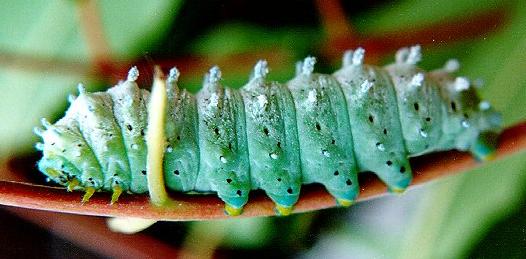
| Ailanthus Silkmoth (previously known as Philosamia cynthia) SATURNIIDAE, BOMBYCOIDEA | (donherbisonevans@yahoo.com) and Stella Crossley |

(Photo: courtesy of Mark Lasko)

| Ailanthus Silkmoth (previously known as Philosamia cynthia) SATURNIIDAE, BOMBYCOIDEA | (donherbisonevans@yahoo.com) and Stella Crossley |

(Photo: courtesy of Mark Lasko)
This Caterpillar is pale turquoise with tubercles (scoli) and is often covered in a fine white powder. The caterpillar feeds on the foliage of a wide variety of plants, including:

The adult moth is brown, and each wing has a broad white line extending from the leading to the trailing edge, and half way along, has a white crescent moon joining it to the hinge. The moths have a wingspan of about 15 cms. The pheromones of this species have been identified.
The species occurs naturally as various subspecies over much of far-east Asia, including
but this species was imported from overseas into many other countries as part of an attempt to start a silk industry there, including
and for the same reason also into
It was first recorded in Sydney in 1907, although there is some doubt that the species imported was actually Samia cynthia, and it may have been another species in the same genus.
Further reading :
David Carter,
Butterflies and Moths,
Collins Eyewitness Handbooks, Sydney 1992, p. 234.
Ian F.B. Common,
Moths of Australia,
Melbourne University Press, 1990, p. 403.
Dru Drury,
in John Obadiah Westwood:
Figures and Descriptions of Foreign Insects,
Illustrations of Exotic Entomology,
Volume 2 (1837), p. 12, and also
Plate 6, fig. 2.
 caterpillar |  butterflies |  Lepidoptera |  moths |  caterpillar |
(updated 22 March 2013, 16 September 2025)